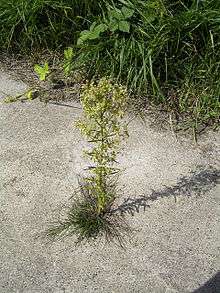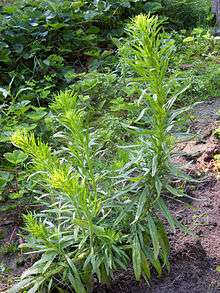Erigeron canadensis
| Erigeron canadensis | |
|---|---|
 | |
| photo taken in Netherlands in 1984 | |
| Scientific classification | |
| Kingdom: | Plantae |
| (unranked): | Angiosperms |
| (unranked): | Eudicots |
| (unranked): | Asterids |
| Order: | Asterales |
| Family: | Asteraceae |
| Tribe: | Astereae |
| Genus: | Erigeron |
| Species: | E. canadensis |
| Binomial name | |
| Erigeron canadensis (L.) Cronquist[1] | |
| Synonyms[1] | |
|
Synonymy
| |

Erigeron canadensis (synonym Conyza canadensis) is an annual plant native throughout most of North America and Central America. It is also widely naturalized in Eurasia and Australia.[2] Common names include horseweed, Canadian horseweed, Canadian fleabane, coltstail, marestail and butterweed. It was the first weed to have developed glyphosate resistance, reported in 2001 from Delaware.
Description
Erigeron canadensis is an annual plant growing to 1.5 m (60 inches) tall, with sparsely hairy stems. The leaves are unstalked, slender, 2–10 cm long and up to 1 cm (0.4 inches) across, with a coarsely toothed margin. They grow in an alternate spiral up the stem and the lower ones wither early. The flowers are produced in dense inflorescences 1 cm in diameter. Each individual flower has a ring of white or pale purple ray florets and a centre of yellow disc florets. The fruit is a cypsela tipped with dirty white down. [3]
Erigeron canadensis can easily be confused with Conyza sumatrensis, which may grow to a height of 2 m, and the more hairy Erigeron bonariensis which does not exceed 1 m (40 inches). Erigeron canadensis is distinguished by bracts that have a brownish inner surface and no red dot at the tip, and are free (or nearly free) of the hairs found on the bracts of the other species.[4][5][6]
Distribution and habitat
Horseweed originated in North America and is very widespread there,[2] but has spread to inhabited areas of most of the temperate zone of Asia,[7] Europe,[3][8] and Australia.[9] It is found in Britain from northern Scotland to Cornwall growing as a weed of arable land. It is not invasive of any natural or semi-natural habitats.
Weed status
Horseweed is commonly considered a weed, and in Ohio it has been declared a noxious weed.[10] It can be found in fields, meadows, and gardens throughout its native range. Horseweed infestations have reduced soybean yields by as much as 83%. It is an especially problematic weed in no-till agriculture, as it is often resistant to glyphosate[11] and other herbicides.[12] Farmers are advised to include 2,4-D or dicamba in a burndown application prior to planting to control horseweed.
Uses
The Zuni people insert the crushed flowers of E. canadensis var. canadensis into the nostrils to cause sneezing, relieving rhinitis.[13] A tincture can be made from the dried flowering tops of the plants.
Horseweed is a preferable material for use in the hand drill method of making friction fire.[3]
References
- 1 2 The Plant List, Erigeron canadensis L.
- 1 2 Biota of North America Program, 2014 county distribution map, Erigeron canadensis
- 1 2 3 "Canadian Fleabane: Conyza canadensis". NatureGate. Retrieved 2013-12-31.
- ↑ Conyza sumatrensis, International Environmental Weed Foundation
- ↑ Green, Deane. "Horseweed, Marestail". Retrieved 2014-08-09.
- ↑ Flora of North America, Conyza canadensis (Linnaeus) Cronquist, Bull. Torrey Bot. Club. 70: 632. 1943. Vergerette du Canada
- ↑ Flora of China, Erigeron canadensis Linnaeus, Sp. Pl. 2: 863. 1753. 小蓬草 xiao peng cao
- ↑ Altervista Flora Italiana, Cespica canadese, avoadinha, Berufkraut, Erigeron canadensis L. includes photos and European distribution map
- ↑ Atlas of Living Australia, Conyza canadensis (L.) Cronquist Canadian Fleabane
- ↑ Germplasm Resources Information Network: Conyza canadensis
- ↑ Van Gessel, MJ (2001). "Confirming glyphosate-resistant horseweed (Conyza canadensis) in Delaware". Weed Sci. 49: 703–712. doi:10.1614/0043-1745.
- ↑ Kruger, Greg R.; Davis, Vince M.; Weller, Stephen C.; Johnson, William G. (2010). "Growth and Seed Production of Horseweed (Conyza canadensis) Populations after Exposure to Postemergence 2,4-D.". Weed Science. 58 (4): 413–419. doi:10.1614/WS-D-10-00022.1.
- ↑ Stevenson, Matilda Coxe 1915 Ethnobotany of the Zuni Indians. SI-BAE Annual Report #30 (p.55)
- A. Davis, K. Renner, C. Sprague, L. Dyer, D. Mutch (2005). Integrated Weed Management. MSU.
- Everitt, J.H.; Lonard, R.L.; Little, C.R. (2007). Weeds in South Texas and Northern Mexico. Lubbock: Texas Tech University Press. ISBN 0-89672-614-2
External links
| Wikimedia Commons has media related to Erigeron canadensis. |
| Wikibooks' A Wikimanual of Gardening has more about this subject: |
- Conyza canadensis, ITIS Report

